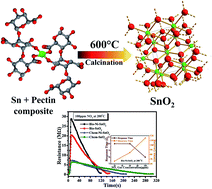Bio-green synthesis of Ni-doped tin oxide nanoparticles and its influence on gas sensing properties
Abstract
Considering the potential applications of transition metal doped nanostructured materials and the advantages of novel, cost-effective and environmentally friendly biosynthesis methods, Ni-doped SnO2 nanomaterials have been synthesized using remnant water (ideally kitchen waste) collected from soaked Bengal gram bean (Cicer arietinum L.) extract. The structural and optical properties of the Ni-doped SnO2 nanostructures were studied using various techniques such as UV/visible spectroscopy, FT-IR spectroscopy, X-ray powder diffraction (XRD), field-emission scanning electron microscopy (FE-SEM) and transmission electron microscopy (TEM). The SEM and TEM images and the XRD results of the biosynthesized Ni–SnO2 nanoparticles reveal a uniform size distribution with an average size of 6 nm and confirmed the formation of a rutile structure with the space group (P42/mnm) and the nanocrystalline nature of the products with a spherical morphology. Subsequently, Ni-doped biosynthesized SnO2 nanoparticles were coated onto a glass substrate using the doctor blade method to form thin films. The NO2 sensing properties of the materials have been studied in comparison with other gases. The reported gas sensing results are promising, which suggest that the Ni-dopant is a promising noble metal additive to fabricate low cost SnO2 based sensors.



 Please wait while we load your content...
Please wait while we load your content...